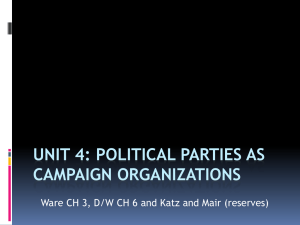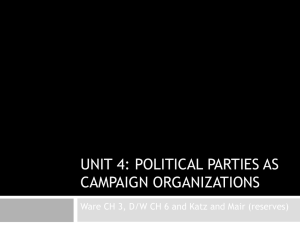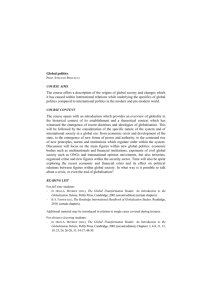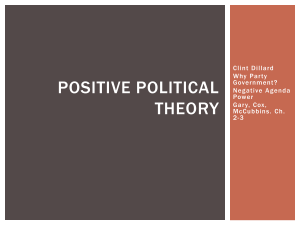Cartel or agents of social conflicts?" Political parties in contemporary
advertisement
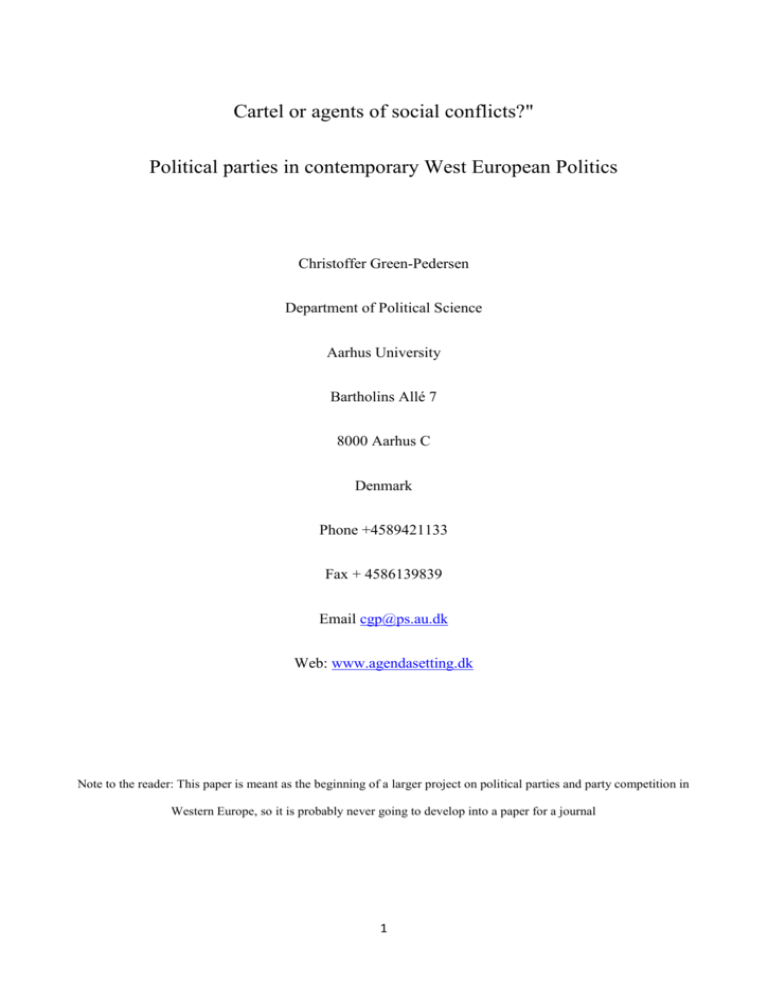
Cartel or agents of social conflicts?" Political parties in contemporary West European Politics Christoffer Green-Pedersen Department of Political Science Aarhus University Bartholins Allé 7 8000 Aarhus C Denmark Phone +4589421133 Fax + 4586139839 Email cgp@ps.au.dk Web: www.agendasetting.dk Note to the reader: This paper is meant as the beginning of a larger project on political parties and party competition in Western Europe, so it is probably never going to develop into a paper for a journal 1 Research into political parties in Western Europe has for a long time been focused on the development of party organizations and party membership. The decline of party membership has been carefully documented (cf. van Biezen et al 2012) and this literature has reached a point where the question is “if the party is over?” (Whiteley 2011). This development of party organization is thus seen as a democratic problem. How are parties capable of acting as the central linkage between citizens and the political system without members? However, as pointed out by Allern & Pedersen (2007), how one views the democratic implications of party organizational change depends crucially on the democratic perspective one applies. The focus on party membership and party organization is often linked with the idea that the internal democracy of political parties is democratically important. But what if one takes a different democratic perspective? From a competitive perspective, i.e. focusing on party competition as the crucial linkage mechanism between citizens and political system, the questions related to party organization are much less important. There is thus growing recognition that in order to assess the role of political parties in contemporary democracy, a much broader focus than the traditional focus on party organizations is needed. Along these lines, recent research into political parties has started to focus on party competition as crucial in linking citizens and the political system. The aim of this paper is to present a critical overview of key studies within this literature. The paper discusses three analyses of party politics in Western Europe or more broadly which have all moved beyond the focus on party organizations. The first one is Katz and Mair’s cartel party hypothesis and the debate surrounding it (1995; 2009). The paper argues that though the cartel thesis is correct in pointing out the integration of political parties into the state, the implication that parties function as a cartel keeping new parties and issues away from the state is only partially true. It underestimates the vote and office seeking 2 incentives of political parties and thus provides a too pessimistic perspective on party competition as a linkage between citizens and the state. The second one is the argument about the emergence of a new globalization cleavage among both the electorate and political parties. This thesis developed by Kriesi and collaborators (2008; 2012) assumes that the new cleavage that has emerged among the electorate is automatically taken into the party system. This is done by radical rights-wing parties which serve as “the agents” mobilizing the losers of the globalization conflict. This thesis provides an overly positive view of party competition as a linkage between citizens and the political system. It lacks an understanding of how the vote and office seeking incentives causes variation in whether or not the issues belonging to the globalization conflict become part of party competition. The third and final one is the analysis of Dalton et al. (2011), who argue that political parties have adapted to new circumstances like the decline in membership and constitute a wellfunctioning linkage between citizens and the political system. However, a central element in this optimistic analysis is congruence between citizens and political parties on a very general left-right scale. This hides considerable variation across issues and countries in terms how the issue preferences of citizens are broad into the political system. Therefore it offers limited insight into when party competition does or does not make parties respond to citizens issue preferences. The three analyses reach different conclusion in terms of how party competition serve as a linkage between citizens and the political system, but they all lack a theoretical understanding of party competition and thus a clear understanding of under what conditions party competition serves as a linkage between citizens and the political system. The paper then outlines how an agenda-setting analysis of party competition can contribute significantly towards understanding the functioning of party competition as linkage between citizens and the political system. 3 The study of party organizations The main focus of many studies of political parties has been the development of party organizations and especially party membership. Such an extensive literature has documented the decline of party membership throughout the Western World (Van Biezen et al. 2012; Whitely 2011). This has led to a discussion of what “parties without partisans” look like (Dalton & Wattenberg 2000)? Parties have become “campaign like organization” (Farrell 2006) which focus on election campaigns, and how they have become integrated with the state (Whitely 2011, see below). One element in this literature has also a more or less explicit concern that this development constitutes a democratic problem (e.g. Dalton & Wattenberg 2000, 261-284). However, the strong focus within the party literature on party members and organizations and the picture of declining importance which has grown out of this focus has also been challenged in several related ways. Katz and Mair (1995) argue that this focus is tight to one particular understanding of political parties namely that of the mass party. Instead, Katz & Mair (1995, 2009) emphasize the integration of political parties into the state through for instance state financing. Political parties with mass membership and a strong focus on their internal democratic structure is but one historical form of political parties. The challenge is to understand the implications of the greater integration of political parties into the state. This is where Katz & Mair launched their idea of the “cartel party, see below. Authors like Allern and Pedersen (2007) and Webb, Farrell & Holiday (2007) have further challenged the often negative implications for democracy which are drawn from changes in party organization, especially the decline in party membership. Which democratic implications to draw from changes in party organization depend on the model of democracy that is taken as point of departure. The literature on party organization has tended to see internal party democracy as an 4 important aspect of democracy more broadly. However, if one for instance builds one a competitive model of democracy, one could argue that fewer members make parties more flexible and thus better able to respond to public preferences (cf. Allern & Pedersen 2007, 73-76). However, the empirical knowledge about whether party competition actually works to secure responsiveness is limited In sum, the literature on political parties has increasingly recognized that unraveling the implications of party organizational changes – which also involves the greater integration between political parties and the state – requires a much broader perspective on political parties than the traditional focus on party organization. With the decline in membership, the prime connection between voters and parties is electoral and this makes a better understanding of how party competition links citizens and political system essential for discussing the role of political parties in contemporary democracies. Partly as a reaction to this recognition within the party literature and partly unrelated to this, a number of analyses of party politics in Western Europe has emerged which all have a much broader focus than party organizations. The question is if these analyses provide a satisfactory analysis of how party competition links citizens and the political system today? The cartel party hypothesis The first analysis is the one offered by Katz and Mair (1995; 2009) in the cartel party hypothesis mentioned above. According to Katz & Mair, parties have increasingly become part of the state. This is visible in for instance the increasing importance of state financing of political parties and in state/party control over modern mass media. Further, existing political parties function as a cartel, 5 which tries to keep competitors, particularly new political parties, away from the benefits of the state. Thus, collution is a central aspect of the cartel party thesis. Parties are not really interested in competing, especially not with new competitors, rather they focus on sharing and dividing the benefits which they enjoy from being part of the state. Often challenges to the party cartel come from outside the party system in the form of interest groups. The cartel party hypothesis has been subject to an intense debate (cf. Katz & Mair 2009, for an overview), but rather limited empirical research. The empirical research which has taken place has focused on the question of the entrance of new parties into the party systems and often challenging the cartel thesis. For instance, Scarrow (2006) does not find support for the idea that increasing state funding keeps new parties away (cf. also Kitshcelt 2000). In terms of understanding contemporary party competition as the link between citizens and the state, the question, however, is why focus should be so strongly on the entrance of new parties. Even if the existing parties are able to keep new parties away from party competition – perhaps because the electoral systems makes parliamentary representation of them difficult, this does far from necessarily imply that existing parties will work as a cartel. Existing parties are still vote and especially office seeking and this is likely to make them compete for instance by introducing new political issues. Thus, though new parties are important for understanding party competition, the question of whether political parties function as a cartel limiting party competition cannot be reduced to the question of the emergence of new political parties. It also needs to involve the vote and office seeking incentives of existing parties, especially the major parties which have traditionally dominated West European governments (Green-Pedersen 2012b). In sum, the cartel hypothesis offers an important point of reference for the discussion of party competition as the mechanism linking citizens and the political system. When taken to its 6 extreme, the cartel party hypothesis implies party competition does not work as such a linking mechanism. Existing parties are not really competing, but are focused on colluding and keeping new competitors away from the benefits of the state. Globalization as a new cleavage in West European politics A very different perspective on the function of West European party politics is provided by Hanspeter Kreisi and collaborators in their idea of the emergence of a new globalization conflict in West European countries. This thesis does not have its roots in party research, but rather in the cleavage tradition which has typically been focused on the electorate (Mair 2006). The idea of Kriesi and collaborators is that a new cleavage has appeared among the electorate between looser and winners of globalization. Globalization - economically, politically, and culturally - benefits certain groups, especially the well-educated, on the expense of others. This leads to a conflict about demarcation and integration. The argument is that this conflict among the electorate is taken into the party by radical right-wing parties which mobilize the losers of globalization. In the party system, the cultural conflict line, which already emerged in the 1970s as the second conflict line in addition to the left-right conflict, is now transformed by radical rightwing parties into a globalization conflict centered on issue like immigration and European integration. Kreisi and collaborators (2008; 2012) find considerable support for the emergence of a new globalization conflict, though the evidence is typically stronger at the level of the electorate than at the party level. At the party level, Kriesi and collaborators themselves point to considerable findings contradicting their argument (cf. Kriesi et al. 2012, 96-126). For instance, a key issue like 7 European integration has been politicized in far from all countries and in some countries radical right-wing parties still play a minor role in the party system. These empirical findings raise a number of more theoretical questions about the globalization conflict and the model of party competition underlying it. First, the globalization conflict is a very broad hat which includes a number of issues like law and order and morality issues which do not necessarily display identical patterns of party competition. Immigration has for instance gained a more prominent place in West European party politics than European integration, but again also with substantial cross-national variation. From the cleavage perspective, various issues may perhaps be considered “functional equivalence”, but in terms of understanding the linkage between citizens and the political system, it is far from unimportant if certain issues like European integration are systematically kept away from party politics in many countries. Understanding why provides exactly an understanding of how party competition functions as a linkage. More generally, the problem with the globalization argument – and actually with the cleavage perspective on which it builds - is that it lacks a theory of party competition. Though the founders of the cleavage tradition, Lipset and Rokkan, (1967), emphasized elite driven mobilization of issues, the tradition has typically worked from a bottom up perspective where conflicts among the electorate are taken into the party system more or less automatically. At least no theory is provided about the conditions where this should or should not take place (Deegan-Krause & Enyedi,2010). Kriesi et al. provides a more elaborated account by presenting radical right-wing parties as the “agents” which take conflicts founds among the electorate into the party systems. Still, there is limited theory of what causes variation in this across issues and countries. One of the reasons for this is probably the very general focus on a globalization conflict rather than the more specific issues on which parties actually compete (cf. Green-Pedersen 2011). 8 Like the cartel party hypothesis, the globalization thesis lacks a theoretical understanding of party competition. However, the implicit conclusion about party competition as a linkage between citizens and political system is very different from the cartel hypothesis. When they exist, radical right-wing parties seem to be able to take the issues belonging to the globalization conflict into party competition. Thus, the transmission of new issues from society into the political systems seems to happen relatively smoothly. At least there is nothing in the theory that would explain when this does not happen. Thus, the theoretical model is essential the same as in the original cleavage literature, which focused on explaining how West European party systems where formed around certain societal cleavage which have then been able to survive also after the weakening or even disappearance of these original social conflicts. New societal conflicts replace original ones. This, however, raises two types of questions. First, party systems today are not “empty” as they were when they were created about a century ago. A central point in the cleavage literature is exactly the “freezing” or institutionalization of party systems and the survival of historical conflict lines. Thus what is the connection between existing and new conflict lines? Second, politics has changed in many fundamental ways compared to a century ago. How does the mediaticization of politics and changes in electoral behavior affect how societal conflicts become part of politics? Especially, the changes in electoral behavior away from socio-structural voting seem to challenge the automatic transmission of societal conflicts into party politics. In sum, the globalization thesis has a very different theoretical starting point compared to the cartel party hypothesis and also implies a very different view of party competition as a linkage between citizens and the political system. Where the cartel party hypothesis sees the party system as closed towards public demands, the globalization thesis implies a very open system where societal conflicts are almost automatically taken into the party system by radical right-wing 9 parties. These implications of both analyses are taken to the extreme, but both lack a theory of party competition explaining under which conditions party systems do and do not function as linkages between voters and the state. Parties as a linkage Recently, Dalton et al (2011) have provided an analysis of parties as linkages which comes out of the recognition of party research to go beyond the focus on party organization. It looks at how parties perform in terms of five aspects of linkage (cf. Lawson 1980), namely campaigns (candidate selection, structure of debate) participatory (mobilization) ideological, representative and policy. The three last ones are all about how parties link the preferences of citizens to the political system. The conclusion of the study is generally one of party adaptation rather than decline. Parties have through for instance institutional or organizational adaptation been able to main the different linkages and thus fulfill their role in the political system. A central element of this argument about party adaptation is the continuing successful ideological linkage between parties and voters. Dalton et al. (op. cit) thus shows how voters locate themselves on a left-right scale, are able to place parties on a left-right scale and use this as the basis for voting. Thus there is strong congruence between voters and parties when one looks at a very general left-right scale (op. cit. 153-155). Further, the study shows how this selection of political parties leads to governments which are generally in agreement with the median voter and that politics matters. Voters are through their choices of the parties that form governments able to influence public policy. 10 This in many very positive view of party adaptation also raises a series of questions. This is clear with regard to the analysis of the ideological linkage, which is a key element as both the representative and the policy linkage rest upon it. As the authors themselves recognize (154155), a central caveat is that congruence of left-right orientation is very general. Left and right, as the study shows (94-97), means different things in different contexts and the very general congruence may hide a lot of incongruence on central issues. Economic issues play a central role, but so do more cultural issues. Further, it is unclear what the mechanism is that provides this congruence. Parties do not compete by placing themselves on a 0 to 10 scale, but by expressing their views on various policy issues. Thus, parties’ ability to respond to new issues must be a central component of party adaptation, but it is unclear when and how parties respond. In sum, the analysis provided by Dalton et al (2011) is important as it moves party research beyond just focusing on party organization into how political parties actually connect citizens and the political system in terms of issue preference. The argument about party adaptation – not least based on the left-right congruence between citizens and parties – share the same optimistic view as Kriesi et al, see above. However, like Kriesi et al. the argument is not grounded on any developed theory of party competition which can provide an explanation for variation across issues and countries which must likely lies behind the very general left-right congruence. What is needed? The three analysis of West European politics presented above all provide important analyses of how party competition work as a linkage between citizens and the political system, though with very different conclusions. However, they all share a lack of a genuine theory of party competition which can explain the conditions under which this linkage works. The findings of both Kriesi and 11 collaborators and Dalton et al. indicate that party competition on a very general level works as a linkage between citizens and the political system thus contradicting the cartel party hypothesis. However, this does not preclude that the on some – important - issues established parties do work as a cartel, which by avoiding attention to certain issues keep new parties out of the party system. Thus to move the debate about the role of political parties, especially party competition, as a linkage between citizens and the political system further, an analysis which compares party competition across a number of countries on a number of issues is needed. We need to understand how much variation across issues and countries exist and what causes it in order to understand how party competition works as a linkage. Further, the analysis needs to focus on both the question of attention and preferences. If party competition is to work as a linkage between citizens and the political system, it needs to work in both respects. The political system needs to prioritize the issues that citizens find important. If the political system neglects issues that citizens find important this is a negative sign in terms of how party competition links citizens and the political system. Attention is, however, not enough. The policies that the political system implements also need to follow citizens’ preferences otherwise it is hard to argue that party competition links citizens and the political system. Therefore, the studies of particular issues will be based on an issue competition perspective which also includes how parties position themselves on issues (e.g. Green-Pedersen 2012a; Green-Pedersen & Krogstrup 2008). Focus will be on two issues which have emerged in West European politics over the past decades, namely European Integration and immigration. The reason for focusing on these two issues is that these are issues that electorate has found important. Thus, an understanding of the extent to which these two issues have been taken up by West European party systems and the extent 12 to which policies have followed citizens preferences will provide considerable value added in terms of how party competition works as a linkage between citizens and the political system. References: Allern, Elin & Karina Pedersen (2007). “The Impact of Party Organisational Changes on Democracy”, West European Politics 30 (1): 68-92. Dalton, Russell and Martin Wattenberg (eds.) (2000). Parties without Partisans. Oxford: Oxford University Press. Dalton, Russell, David Farrell & Ian McAllister (2011). Political Parties & Democratic Linkage, Oxford, Oxford University press Green-Pedersen, Christoffer (2011). Partier i nye tider. Den politiske dagsorden i Danmark. Aarhus: Aarhus Universitetsforlag. Green-Pedersen, Christoffer (2012a). A Giant Fast Asleep? Political Studies 60 (1): 115-30. Green-Pedersen, Christoffer (2012b). “The Cartel Party Thesis Revisited”,pp. 147-154 in, Jens Blom-Hansen, Christoffer Green-Pedersen & Svend-Erik Skaaning (eds.). Democracy, Elections and Political Parties. Essays in honor of Jørgen Elklit. Aarhus Politica. Green-Pedersen, Christoffer and Jesper Krogstrup (2008). Immigration as a Political Issue In Denmark And Sweden. How Party Competition Shapes Political Agendas. European Journal of Political Research 47 (5): 610-34. Katz, Richard and Peter Mair (1995). Changing Models of Party Organization and Party Democracy. Party Politics 1 (1): 5-28. Katz, Richard and Peter Mair (2009). The Cartel Party Thesis. A Restatement. Perspectives on Politics 7 (4): 753-67. Kitschelt, Herbert (2000). Citizens, Politicians and Party Cartelization. European Journal of Political Research 37 (2): 149-79. Kriesi, Hanspeter, Edgar Grande, Romian Lachat, Martin Dolezal, Simon Bornschier and Timotheus Frey (2008). West European Politics in the Age of Globalization. Cambridge: Cambridge University Press. Kriesi, Hanspeter, Edgar Grande, Martin Dolezal, Marc Helbinger, Dominic Höglinger, Swen Hutter and Bruno Wüest, (2012) Political Conflict in Western Europe, Cambridge, Cambridge University Press Lipset, Seymour M. & Stein Rokkan (red.) (1967). Party Systems & Voter Alignments, New York: The Free Press. Mair, Peter (2006). “Cleavages”, pp. 371-375 i Richard Katz & William Crotty (red.), Handbook of Party Politics, London: Sage. 13 Scarrow, Susan (2006). Party Subsidies and the Freezing of Party Competition. Do Cartels Work? West European Politics 29 (4): 619-39. van Biezen, Ingrid, Peter Mair and Thomas Poguntke (2011). Going, Going, ... Gone? The Decline of Party Membership in Contemporary Europe. European Journal of Political Research 51 (1): 24-56. Whiteley, Paul (2011). Is the Party Over? The Decline of Party Activism and Membership across the Democratic World. Party Politics 17 (1): 21-44. Webb, Paul, David M. Farrell & Ian Holliday (red.) (2002). Political Parties in Advanced Industrial Countries, Oxford: Oxford University Press. 14
